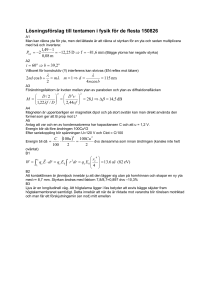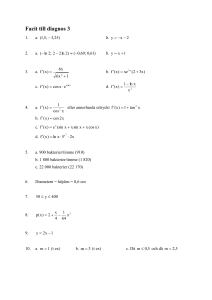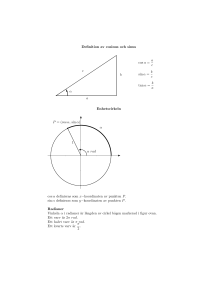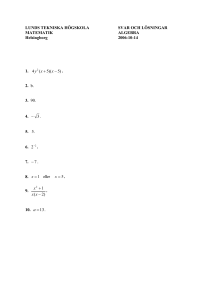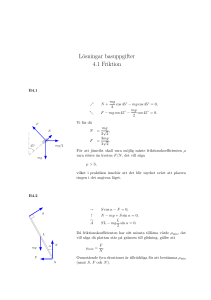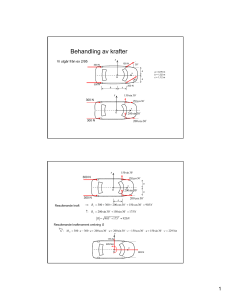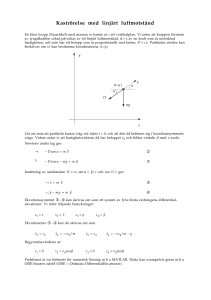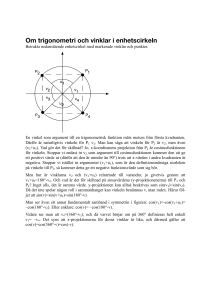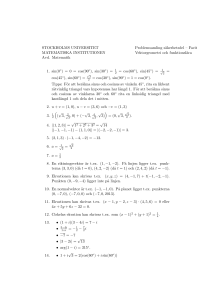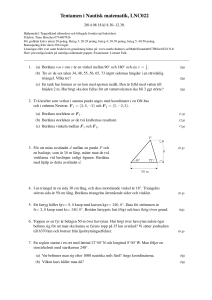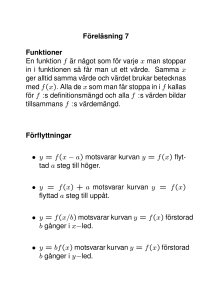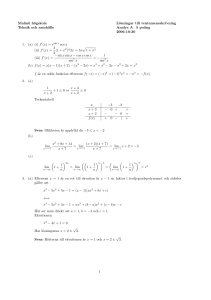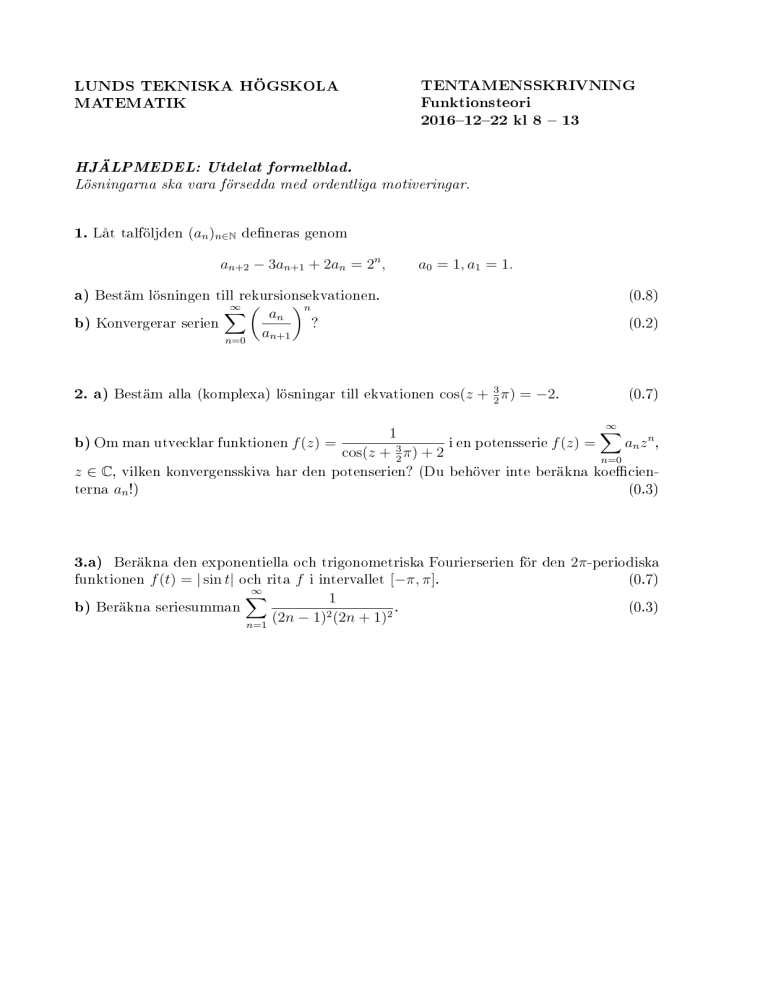
TENTAMENSSKRIVNING
Funktionsteori
20161222 kl 8 13
LUNDS TEKNISKA HÖGSKOLA
MATEMATIK
HJÄLPMEDEL: Utdelat formelblad.
Lösningarna ska vara försedda med ordentliga motiveringar.
1. Låt talföljden (an )n∈N deneras genom
an+2 − 3an+1 + 2an = 2n ,
a0 = 1, a1 = 1.
a) Bestäm lösningen till rekursionsekvationen.
b) Konvergerar serien
∞
X
an
an+1
(0.8)
n
?
(0.2)
2. a) Bestäm alla (komplexa) lösningar till ekvationen cos(z + 23 π) = −2.
(0.7)
n=0
∞
X
1
an z n ,
i
en
potensserie
f
(z)
=
b) Om man utvecklar funktionen f (z) =
cos(z + 32 π) + 2
n=0
z ∈ C, vilken konvergensskiva har den potenserien? (Du behöver inte beräkna koecienterna an !)
(0.3)
3.a) Beräkna den exponentiella och trigonometriska Fourierserien för den 2π -periodiska
funktionen f (t) = | sin t| och rita f i intervallet [−π, π].
(0.7)
b) Beräkna seriesumman
∞
X
n=1
1
(2n −
1)2 (2n
+ 1)2
.
(0.3)
4. Låt f (x+iy) = u(x, y)+iv(x, y) vara en hel funktion. Antag att u(x, y) = g(x) cos y för
en två gånger kontinuerligt deriverbar funktion g . Bestäm f (z) som uppfyller f (0) = 1 + i
och f (i π2 ) = 2i.
5. a) Beräkna
Z
0
∞
cos(2x)
dx.
1 + x2
(0.6)
b) Låt γ vara en sluten slät kurva i C \ {±i}. Vilka värden kan integralen
Z
γ
anta?
6. a) För vilka komplexa tal z konvergerar/divergerar serien
∞
X
n=1
zn
?
1 − zn
cos(2z)
dz
1 + z2
(0.4)
(0.7)
b) För ett naturligt tal n deneras funktionsvärdet ψ(n) som antalet positiva delare till n.
Exempelvis delar 1, 2, 3, 6 talet 6 och ψ(6) = 4. Visa att
∞
X
n=1
∞
X
zn
=
ψ(n)z n
1 − zn
n=1
för |z| < 1.
(0.3)
Lycka till!
LUNDS TEKNISKA HÖGSKOLA
MATEMATIK
LÖSNINGAR
Funktionsteorie
20111222
1.a) Characteristic equation for the homogeneous solution is
r2 − 3r + 2 = 0,
r1 = 1, r2 = 2.
The homogeneous solution is therefore
ahn = c1 + c2 2n .
Ansatz for the particular solution (2 is a root of the characteristic equation):
apn = cn2n
gives c = 21 . Fitting the initial conditions, i.e. adapt the constants c1 , c2 gives
an = 2 − 2n + 2n−1 .
an n :
b) We apply the root crterion to bn = an+1 lim
n→∞
b1/n
n
1
n2n−1 − n1 + 12 1
2 − 2n + n2n−1 = < 1.
= lim 1
= lim 1
2
n→∞
n→∞ 2 − 2n+1 + (n + 1)2n −
+
1
n−1
n2
n
Therefore the series converges.
2. We will use Euler's formula and set w = eiz+i 2 π . We get
3
1
= −4
w
w+
or
w2 + 4w + 1 = 0.
√
Hence w1,2 = −2 ± 3 och
√
√
3
i(z + π) = log(−2 ± 3) = ln(2 ∓ 3) + (2k + 1)πi,
2
Finally,
z = −i ln(2 ∓
√
1
3) + (2k − )π,
2
k ∈ Z.
k ∈ Z.
b) The radius of convergence equals the distance from the origin (the series is centered at
z = 0) √
to the closest singularity,
i.e. to the closest solution of the equation from a). We have
√
ln(2 + 3) = − ln(2 − 3) and therefore (with k = 0) the series converges for
(
z∈
w ∈ C : |w| <
r
)
√
π2
+ ln2 (2 + 3) .
4
3.a) f is even, so bk = 0. For the exponential series we have
1 π
1
ck =
∈−π | sin t|e−ikt dt =
2π
π
Z
0
π
sin te−ikt dt.
Since e−ik(t−π) = (−1)k eikt follows ck = 0 for odd k.
c2k
1
=
π
Z
π
−2kit
sin te
0
1
dt =
2πi
Z
π
0
1
4
eit − e−it e−2kit dt = −
2
2π 4k − 1
1
4
=−
.
2π (2k + 1)(2k − 1)
Using ak = ck + c−k (and the continuity of f ) we get
∞
∞
4
2
1X
4
1 X
2kit
e
= −
cos(2kt).
| sin t| = −
2π k=−∞ (2k + 1)(2k − 1)
π π k=1 (2k + 1)(2k − 1)
b) We will use Parseval's formula.
∞
π
Z
1
1
=
2
2π
| sin t|2 dt =
−π
Therefore
∞
X
k=1
4
1
1 16 X
+
.
π 2 2 π 2 k=1 (2k − 1)2 (2k + 1)2
π2 1
1
=
− .
(2k − 1)2 (2k + 1)2
16 2
4.a) u has to be harmonic, so
or
0 ≡ u00xx + u00yy = (g 00 (x) − g(x)) cos y
g 00 (x) = g(x).
The latter dierential equation has the general solution g(x) = c1 ex + c2 e−x . We also have
f (0) = 1 + i =⇒ u(0, 0) = 1 =⇒ g(0) = 1 =⇒ c1 + c2 = 1. We seperate
u(x, y) = (c1 ex + (1 − c1 )e−x ) cos y = c1 ex cos y + (1 − c1 )e−x cos y = u1 + u2 .
The harmonic conjugates are v1 (x, y) = c1 ex sin y + d1 and v2 (x, y) = −(1 − c1 )e−x sin y + d2 ,
d1,2 ∈ R, respectively. Setting z = x, y = 0 and using the identity theorem we get
f (z) = c1 ez + (1 − c1 )e−z + id
d ∈ R.
Finally, f (0) = 1 + i =⇒ d = 1 and f (i π2 ) = 2i =⇒ c1 = 1. Hence, f (z) = ez + i.
5.a) We use cos(2x) = Re(e2ix ) and consider
Z
C
e2iz
dz =
1 + z2
Z
R
−R
e2ix
dx +
1 + x2
Z
CR
e2iz
dz
1 + z2
where CR = {z ∈ C : |z| = R, Im(z) > 0}. By Jordan's lemma the second integral on the
right-hand-side vanishes as R → ∞. Using the residue theorem (z = i is the only singularity
surrounded by C ) we get
Z
∞
−∞
cos(2x)
dx = Re
1 + x2
Z
∞
−∞
2iz e2ix
e
dx = Re 2πi · Resz=i
= πe−2 .
2
2
1+x
1+z
2
cos(2z)
b) The function f (z) =
has two singularities z1,2 = ±i. Let γ be a closed smooth
1 + z2
curve. By Wi (γ), W−i (γ) ∈ Z we denote the winding number (with orientation) of γ around i,
respectively −i. That is we count how often the curve γ encircles each singularity taking into
account the direction. The residue theorem says
Z
f (z) dz = 2πi (Wi (γ)Resz=i (f (z)) + W−i (γ)Resz=−i (f (z))) = Wi (γ)π cos(2i) − W−i (γ)π cos(2i)
γ
= mπ cos(2i),
where m = m(γ) = Wi (γ) − W−i (γ) is an arbitrary integer (depending on the curve γ ).
6.a) Let 0 < r < 1 and |z| ≤ r then
∞ ∞
∞
X
zn X
r
rn
1 X n
≤
r =
<∞
≤
1 − zn n
1−r
1 − r n=1
1−r
n=1
n=1
and the series converges uniformly on {z ∈ C : |z| ≤ r} and hence converges for |z| < 1.
If |z| > 1 then
zn 1
≥ lim
lim n
n→∞ 1 − z
n→∞ 1 −
1
|z|n
=1>0
and the series diverges since the terms do not tend to zero.
If |z| = 1 then |1 − z n | ≤ 2 and
zn 1
≥ >0
lim n→∞ 1 − z n 2
and again the series does not converge.
To summarize the series diverges for |z| ≥ 1, converges for |z| < 1 (and converges uniformly on
each disc |z| ≤ r < 1).
p
Remark: The series is not dened for z = ei q π , p, q ∈ Z.
b) Let |z| ≤ r < 1. By the view of a) the left-hand-side series converges uniformly and we can
∞
X
1
(z k )l for |z| < 1,
change the order of the terms in an arbitrary manner. By using
=
1 − zk
l=0
we conclude
∞
X
n=1
∞
∞
X zk
X
zn
=
=
zk
n
k
1−z
1−z
k=1
k=1
=
∞ X
X
n=1 k|n
zn =
∞
X
∞
X
(z k )l
l=0
ψ(n)z n .
n=1
3
!
=
∞ X
∞
X
k=1 l=0
z (l+1)k

